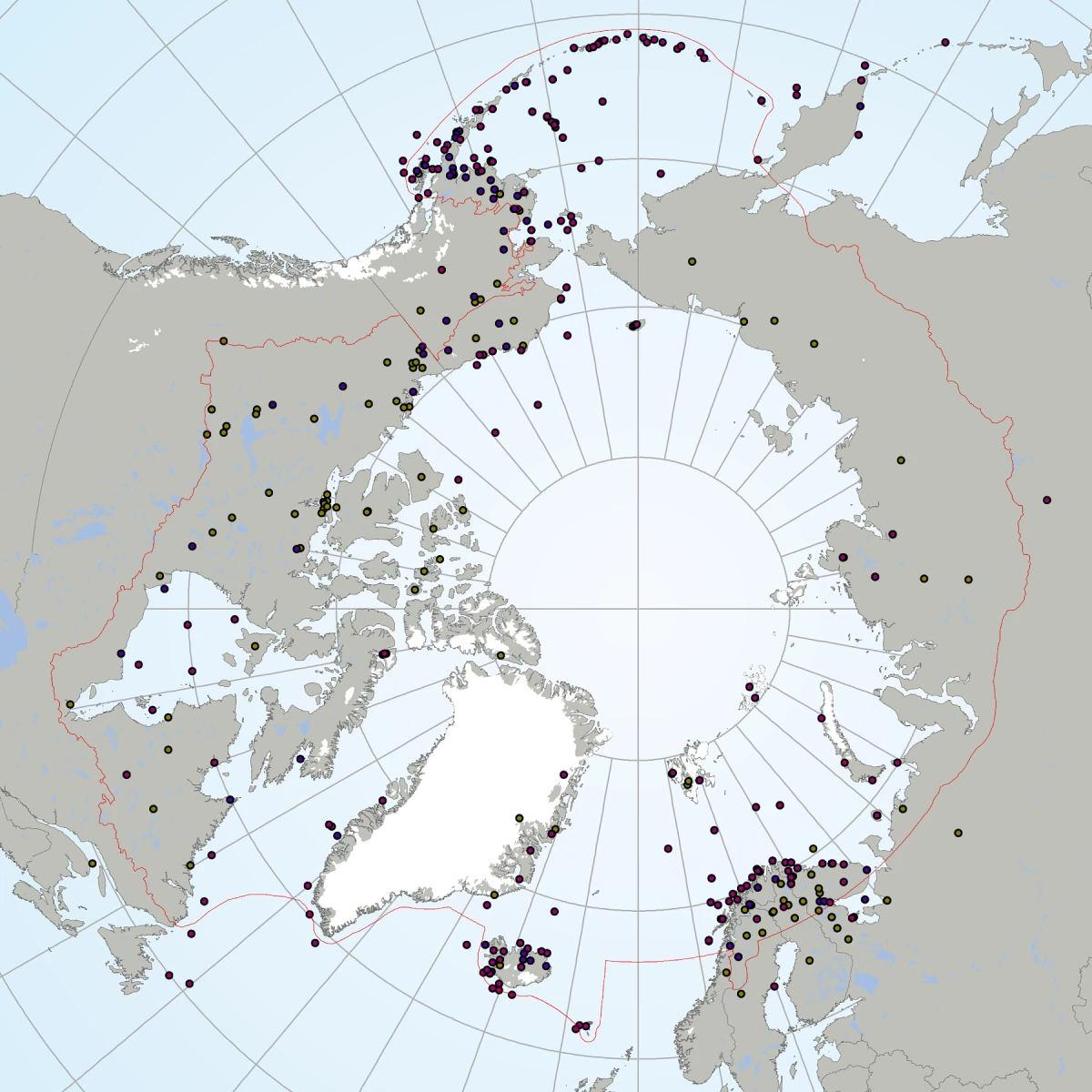
Arctic Species Trend Index (ASTI)
The Arctic Species Trend Index (ASTI) tracks trends in over 300 Arctic vertebrate species and comprises the Arctic component of the Living Planet Index.
The Arctic Species Trend Index (ASTI) describes overall trends across species, taxonomy, ecosystems, regions and other categories.
The ASTI uses population monitoring data and allows for a composite measure of the overall population trends of 890 populations of 323 Arctic vertebrates species between 1970 and 2007. This is 37% of all known vertebrate species, a high figure for such an index. It can also be organized to display trends based on taxonomy, biome or region. It allows scientists to track broad trends in the Arctic's living resources and identify potential causes of those trends, whether they are responses to natural phenomena or human-induced stressors.
The ASTI is a significant accomplishment and recognition of the sustained effort and dedication of Arctic researchers and communities who have been tracking wildlife populations over the past four decades and beyond in a remote and challenging environment. Over time, tracking this index will help reveal patterns in Arctic wildlife response to growing pressures, thereby helping to better predict change and develop and inform effective conservation and adaptation strategies.
The ASTI is the Arctic component of the Living Planet Index.
Since its development, ASTI has produced several analyses:

The Arctic Species Trend Index 2010: the first ASTI assessment
The 2010 report tracks 965 populations of 306 species, representing 35% of all known vertebrate species found in the Arctic using vertebrate population-abundance data over the past 34 years (using 1970 as the baseline).
The report found that vertebrate abundance in High Arctic species declined 26% between 1970 and 2004. Low and Sub Arctic species fared better over this time period: Low Arctic species experienced increasing abundance and Sub Arctic species showed a decline since the mid-1980s, but no overall change over the 34-year period.
These observed trends are largely consistent with predictions regarding the response of Arctic wildlife to climate change and expected increases in previously over-harvested species, and suggest that human-induced changes in Arctic ecosystems are already resulting in winners and losers. Dramatic growth of certain populations of migratory Arctic-nesting geese species, for instance, shows a contrast with a steady decline in other herbivorous species, most of which are not migratory.
While this report highlights trends seen over 34 years, further work is needed to produce a more robust ASTI that adequately represents all taxa, biomes and regions and to develop a better understanding of how the Arctic’s wildlife is responding to both natural and human-induced changes.

The average population of Arctic species increased by 16% between 1970 and 2004, however, this is not consistent across biomes, regions, and taxa. (Source: ASTI 2010)

Arctic grazing species (aside from migratory geese) have declined 20% between 1985 and 2004. The reason for the decline is unknown. (Source: ASTI 2010)

High Arctic species populations have decreased by an average of 26% between 1970 and 2004. (Source: ASTI 2010)

Migratory Arctic nesting geese species have almost doubled since the 1970s largely due to increased agricultural waste. (Source: ASTI 2010)
Arctic Species Trend Index, 2011: in-depth look at trends in marine species and through space and time
The data set underlying the index was updated by acquiring new data, removing redundant data sets, and extending time series. The ASTI now included data for 323 species, increasing representation of Arctic vertebrate species from 35% (in the 2010 index) to 37%. These species were represented by trend data from 890 populations and new ASTI values were calculated for each year from 1970 to 2007.
Average abundance of Arctic vertebrates increased from 1970 until 1990 then remained fairly stable through 2007, as measured by the ASTI 2011.When species abundance is grouped by broad ecozones, a different picture emerges, with low Arctic species abundance increasing in the first two decades much more than high Arctic and sub Arctic species abundance. The low Arctic index has stabilized since the mid-1990s while the high Arctic index appears to be recovering in recent years and the sub Arctic index has been declining since a peak in the mid-1980s.
The trend for Arctic marine species is similar to that of the overall ASTI, while the trend for terrestrial species shows a quite different pattern: a steady decline after the early 1990s to a level below the 1970 baseline by 2005.
Tracking trends in Arctic marine populations
The trend for marine fish is very similar to the trend for all marine species, increasing from 1970 to about 1990 and then levelling off. This indicates that the ASTI is strongly influenced by fish trends. Overall, marine mammals also increased, while marine birds showed less change.
The three ocean regions, Pacific, Atlantic, and Arctic, differed significantly in average population trends with an overall decline in abundance in the Atlantic, a small average increase in the Arctic and a dramatic increase in the Pacific. These differences seem to be largely driven by variation in fish population abundance—there were no significant regional differences for birds or mammals.
Pelagic fish abundance appears to cycle on a time frame of about 10 years. These cycles showed a strong association with a large-scale climate oscillation.
The ASTI data set contains population trends for nine sea ice associated species. There were mixed trends among the 36 populations with just over half showing an overall decline.
The Bering Sea and Aleutian Island (BSAI) region of the Pacific Ocean is well studied, providing an opportunity to examine trends in more detail. Since 1970, BSAI marine fish and mammals showed overall increases, while marine birds declined. However, since the late 1980s, marine mammal abundance has declined while marine fish abundance has largely stabilized.

Tracking trends through space and time
Spatial analysis of the full ASTI data set (1951 to 2010) started with an evaluation of vertebrate population trend data from around the Arctic. The maps produced from this analysis provide information useful for identifying gaps and setting priorities for biodiversity monitoring programs.
Mapping trends in vertebrate populations provides information on patterns of biodiversity change over space and time, especially when examined at regional scales.
Understanding of the causes of Arctic vertebrate population change can be improved by expanding the spatial analysis of ASTI data to include spatial data on variables that represent drivers of biodiversity change.

The Arctic Migratory Birds Index, 2015: an analysis of the Arctic Species Trend Index
The Arctic Migratory Birds Index - a subset of the Arctic Species Trend Index - describes the broad-scale trends in 129 selected migratory bird species.
Selected species have increased in abundance by 40% on average between 1970 and 2011. However, this overall trend masks differences between taxa and in flyway regions, with declines in East Asia and Central Asia (-40% and -70%), and recoveries in Africa-Eurasia and the Americas (50% and 15%).
Shorebirds are in decline overall (-10%), with negative trends in the Americas and East Asia (-10% and -70%). Populations of this group are faring better in Africa-Eurasia, where abundance is 40% higher compared to 1970.
Waterfowl have increased across all flyway regions mainly due to geese, but there are differences in the underlying trends for geese/swans and for ducks. Geese and swans combined more than quadrupled in abundance between 1970 and 2011, showing positive change across regions, although coverage is too patchy for reliable conclusions. The increase in geese/swans is largely driven by geese, which make up the majority of this data set. Swans have been in decline since 1994. Duck abundance is 10% lower overall, but there are regional differences, with a halving in the Americas and a 70% increase in Africa-Eurasia.
The international scientific team incorporated information from both inside and outside the Arctic to capture possible influences at different points during a species’ annual cycle.

 Arctic Council Working Group
Arctic Council Working Group 



